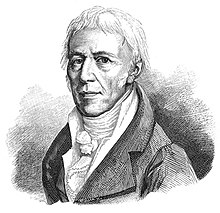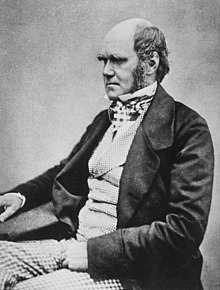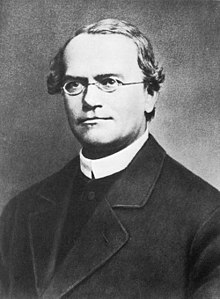Evolution
Evolution as portrayed by Charles Darwin/Theory of Evolution. |
Evolution is, by simple definition, change over time. Many early beliefs have spewed around the idea of evolution, such as spontaneous generation (the idea that life could arise from non-living matter) and biogenesis (the idea that life can only come from pre-existing life).
Scientific Developments
[edit | edit source]Taxonomy is a branch of biology that deals with naming and classifying the diverse forms of life. Taxonomy was founded by Carolus Linnaeus. Taxonomy helped Darwin formulate his arguments for evolution.
Fossils
[edit | edit source]Fossils are found in rock layers known as "strata"--with the help of relative dating, scientists are able to study strata. Many new tips have been found in order to accommodate scientists in their studies of rocks (rock layers on the top are younger; rock layers on the bottom are older). The studying of rocks have allowed scientists to formulate geologic time scales:
- Precambrian (oldest); 85%
- Paleozoic; 10%
- Mesozoic; 4%
- Cenozoic (youngest); 1.5%
Paleontology, study of fossils. Fossil records illustrate that organisms change over time.
Rates of Change
[edit | edit source]
Gradualism
[edit | edit source]Gradualism is a widely known theory, proposed by Englishmen James Hutton in 1795, that evolution and change occur due to small changes over a period of time. An example of this theory, stated in "Gradualism in the Animal World", examples.yourdictionary, is when elephants, due to the hard-hit rays of the sun, develop (over a period of time) larger ears---or, the elephant's ears slowly, and over time, become larger in order to help the elephants seek protection/shade from the sun.
Punctuated Equilibrium
[edit | edit source]Unlike gradualism, punctuated equilibrium, proposed that change occurred in starts and fits. Changes were usually due to a brief geological event such as a tornado or an asteroid that caused a change in the environment.
Scientists
[edit | edit source]Jean Baptiste Lamarck
[edit | edit source]
Jean Baptiste Lamarck was a French biologist who proposed theories on adaptation before Charles Darwin published his theories on evolution. His two theories were Use and Disuse and Inheritance of Acquired Traits---both of these theories intertwine together.
Use and Disuse & Inheritance of Acquired Traits
[edit | edit source]Use and disuse is a theory that proposes that organisms that do not use a particular structure (long neck) would lose their structure over time OR if they continually used a structure, they would pass it on to their offspring (if a giraffe continually stretches their neck, their [offspring] would eventually acquire longer and longer necks). If the trait [that is gained] (for this example, longer necks) is passed on to the offspring, this is known as Inheritance of Acquired Traits. Although this theory was formally established by Lamarck, the idea behind this theory had been widely known for years and years, including the era of Hippocrates and Aristotle... even widely accepted in the 18th century (1700s).
Charles Darwin
[edit | edit source]
Charles Darwin was an English biologist who founded the theory of evolution. He published The Origin of Species by Means of Natural Selection in 1859. Before his work was published, Darwin and Alfred Wallace jointly presented their ideas on evolution to the scientific community. In his arguments, he used his experience of being a Shipman on the HMS Beagle (observation throughout his voyage around the world) and fossil evidence to support his arguments. In his book, Darwin proposed his argument for natural selection as the main mechanism for evolution.
Darwin's 5-part Theory of Evolution
[edit | edit source]- There are variations in populations.
- Some variations are more immediately helpful than others.
- More offspring are produced than can survive.
- The organisms with more helpful variations will survive to produce more offspring than organisms with less-helpful variations.
- Over time, favorable adaptations will become more common and unfavorable adaptations will become less common.
Natural Selection
[edit | edit source]Natural Selection, often referred to as "survival of the fittest", refers to the natural process where organisms better adapted to their environments survive and reproduce more than organisms without those adaptations.
This flow chart indicates the process of evolving a new species through natural selection (remember: variation already exists in the genes! Changing the phenotype does NOT change the genotype):
Natural variation occurs through 2 main mechanisms, Gene Flow (migration of individuals among populations, which has the effect of moving their DNA around) and Mutations (changes in DNA sequence). Evolution (change) occurs when the types of variation seen in a populations changes.
Other mechanisms for changing variation consist of genetic drift (when a genetics of population changes due to chance, with no particular reference to the organism's environment) and a founder effect, which occurs when a few individuals from a larger population colonize an isolated island or new habitat, and variations those founding population members do not have, can not enter the new territory. Both these processes changs the amount and kind of variation in a population.
Evidences
[edit | edit source]Much evidence for evolution has been found. This evidence includes fossil records of past life which are similar, but not identical, to living species. The presence of homologous structures, which are body parts of organisms that may have the same embryonic origin but different functions in different organisms. Vestigial structures, structures found in some organisms even though they may have no use for the structure. The study of embryology, and the finding that embryos many species look similar to each other at different stages of development (ontology), which provides evidence that DNA sequences controlling early development in different organisms may remain similar/unchanged. Also general comparative anatomy, which is the study of organisms and their structures (internal and external).
Genetics
[edit | edit source]
Charles Darwin did not know that genes control heritable traits, which is why Charles Darwin's works and Gregor Mendel's works were not "connected" by evolutionary biologists. Due to our current knowledge of the topic of genetics, we can now adequately define evolution in terms [of] genetics.
Genetic Variation
[edit | edit source]A few terms to be known:
- Gene Pool: All of the genes, including all of the different alleles, present in a population.
- Allelic Frequency: How often an allele occurs in a specific gene pool.
- Evolution as defined by genetics: Any change in the allelic frequency of alleles in a population.
- Single gene trait: A trait controlled by a gene that has two alleles.
- Polygenic trait: A trait controlled by a gene that has two+ alleles.
Genetic variation arises through mutations, gene shuffling (Law of Independent Assortment, crossing over during meiosis, etc.)--note: gene shuffling does not change the allelic frequency of alleles, but rather produces different phenotypes.
Evolution as Genetic Change
[edit | edit source]One thing to make sure of is that natural selection never acts directly on genes, but rather it only affects which individuals will survive and reproduce and which individuals will not. If an individual dies without reproducing, then he/she will not contribute its alleles to the gene pool. Though, if an individual produces many offspring than its alleles will stay in the gene pool and may increase in frequency.
- Natural selection on single-gene traits
Natural selection on single-gene traits can lead to changes in allele frequencies and thus to evolution.
Curves
[edit | edit source]When individuals at one end of the curve have higher fitness than individuals in the middle/the other end of the curve.
When individuals at the center of the curve have higher fitness than individuals at either end of the curve.
When individuals at the upper and lower ends of the curve have higher fitness than individuals near the middle of the curve.
Hardy-Weinberg Principle
[edit | edit source]The Hardy–Weinberg principle is the percentage of each allele in a population will remain the same unless something causes it to change. When the presence of each allele remains constant in a population, it is known as genetic equilibrium. Five conditions for genetic equilibrium have been set:
- There must be random mating.
- The population must be very large.
- There can be no movement in or out of the population.
- There can be no mutations.
- There can be no natural selection.
The Process of Speciation
[edit | edit source]A species is a group of organisms that breed with one another and can produce fertile offspring. Speciation is the formation of new species.
Isolating Mechanism
[edit | edit source]Isolating Mechanism is the way, stated from evolutionist scientists, that a species evolve into two new species.
When members of two populations can mate but no fertile offspring (horse and donkey: mule).
When two populations are capable of mating but have different courtship rituals or other reproductive strategies involving behavior (bird songs).
Two populations are separated by geographic barriers such as rivers, mountains, or other bodies of water. This is usually caused by an accident/coincidence (fish from different streams).
When two or more species will reproduce at different times of the day, month year, etc (American toad and Fowler's toad).
Evolution/Radiation
[edit | edit source]The process by which a single species/small group of species evolves into several different forms that live in different ways; rapid growth in the diversity of a group of organisms.
The process by which unrelated organisms independently evolve similarities when adapting to similar environments (dolphins and sharks).
See Adaptive Radiation.
